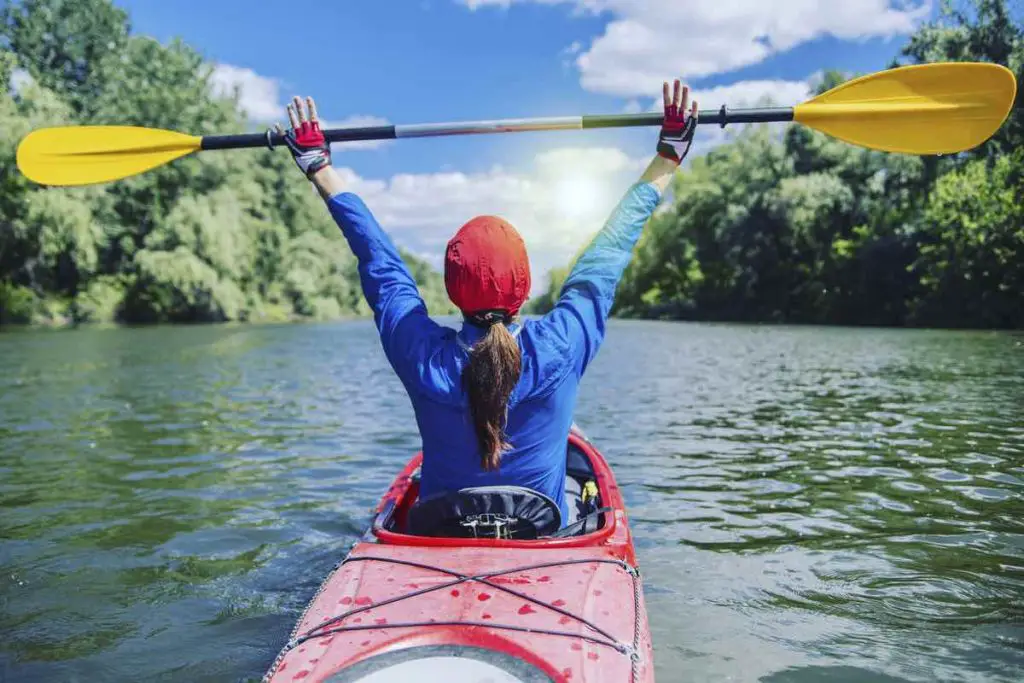When kayaking through a canal, you may end up encountering a lock, which allows passage into areas that some water vessels otherwise could n’t travel through. Locks are typically used for boats and ships, but are they safe for kayaks to go through?
Kayaks can safely go through locks. However, you must have knowledge of how locks work and receive instructions from the lock operator before going through them. For better stability, hold onto the drop cables when inside the lock chamber while it’s filling or emptying water.
In this article, I’ll teach you how to safely take your kayak through locks, offer tips, and discuss the different signals and meanings you’ll encounter during your lock experience.

How to Safely Go through a Lock With a Kayak
When planning a kayaking trip, you should research the area where you’re kayaking and look for any locks you might encounter. This helps you prepare mentally and know what to expect during your excursion.
Here are the steps you should take to safely go through a lock with a kayak:
1. Alert the Lock Operator
When you’re coming up on a lock, you should first signal the lock master. You’ll need to let them know the type of vessel you’re in, how many people are with you, and what direction you’re going. There are three ways to do this:
- Call on a mobile phone.
- Radio to them.
- Push the button or pull the rope in the signaling area.
2. Wait for the Signal Before Entering the Lock
Once you alert the operator that you’re approaching the lock, you’ll need to wait patiently for the operator to signal you through. The gate will open up, and the operator will signal you in after it’s completely clear of water vessels leaving.
3. Enter the Lock Slowly
Once you get the go-ahead from the operator, you may proceed into the lock slowly. It’s best to navigate to an area along one of the side walls. There you will be out of the way of other watercraft, and you’ll stay clear of the gates.
The gate will close the chamber to allow the water to either begin to rise or empty. There will be drop cables along the wall for you to hold onto for stability, as it may get slightly rough at times during the change in depth.
4. Exit the Lock
Once the water is at the required level for the direction you’re going in, the gate will open, and the lock operator will signal that it’s safe to exit the lock. Ensure that you move toward the exit carefully. Once the operator directs you to exit, you may continue your journey through the gate.
5. If It Feels Unsafe, Portage Around the Lock
If you ever approach a very busy lock that feels unsafe, another option is to portage around it. This is easiest to do with two people, as you’ll have to carry your kayak out of the water and walk it on land until you’ve made it around the lock.
Tips To Make Navigating a Lock in a Kayak Easier
- Wear a pair of kayaking gloves like these Neosport Neoprene Gloves (found on Amazon.com). These gloves provide a good grip for holding onto the drop ropes in the lock and protect your hands from scraping up against the cement wall and rope burn when being jostled when the water is rough.
- Stay toward the back of the lock for a less turbulent experience. The front of the lock gets you thrown around a bit more due to the strong current from the water rising or emptying in the chamber. Being in the front is manageable but may require more effort to hold on to the drop rope.
- Be courteous of other travelers when going through the lock. You may have to wait to have a turn to enter. Military craft, mail boats, and commercial boats have right of way before recreational watercraft may go. Stay patient during this process, as it may be a while before the operator gets to you.
Understanding the Horns and Lock Signals
Understanding all the different signals is imperative so that you and anyone else using the lock stay safe. The signals used in a lock will be shown with a traffic light and an air horn. The operator uses the signals to communicate with all travelers navigating the lock.
Traffic Light Signals
There are three main traffic light signals that you need to know before encountering a lock:
- Red flashing light: this color light lets you know to stay clear of the lock and not to enter. This could be because watercraft is leaving the lock chamber, so you need to be out of the way for them to pass. Therefore, stay patient and wait for the operator’s signal that it’s safe to enter.
- Amber flashing light: this color light tells you to approach the lock slowly and cautiously. When the amber light is flashing, you can begin making your way to the lock guide wall. However, always be mindful of the other boaters around you, and be sure to give any other boaters plenty of room.
- Green flashing light: this color light lets you know that there’s no other boat traffic, so you can now safely enter the lock. Proceed into the lock slowly and take your place along the lock wall.
Air Horn Signals
There are three different types of air horn blasts you need to remember when going through a lock:
- One long air horn blast: signals that it’s safe to enter the lock.
- One short air horn blast: means that you may now exit the lock.
- Five short air horn blasts: indicates danger.
Launching a kayak is not limited to a specific type of site because it’s lightweight and easy to carry. You can launch it from any public location. However, not all areas are ideal. Read my guide to learn how to choose the best area for launching a kayak and how to launch it in different locations.

Conclusion
Safely navigating a lock can be nerve-wracking if you’ve never done it before. It helps to know what to expect during the experience, giving you the confidence to explore it on your next kayaking adventure. Remember to take your time and use the knowledge you’ve gained from this article to go through the lock safely and successfully.
Sources
- Canoe & Kayak Direct: All You Need to Know About Paddling on Canals
- Baffin Paddler: What it’s Like Going Through a Lock in a Sea Kayak on the Rideau Canal
- ABC Boat Hire: How Do Canal Locks Work?
- Youtube Escape With Jay: How to Go Through a Lock (Mississippi River)
- Pontooners: Which Flashing Light Tells You to Enter a River Lock?
- Boating Basics Online: When Arriving at a Navigation Lock, What is the Order of Priority?
- Erie Canalway: Tips for Boating Through a Lock
